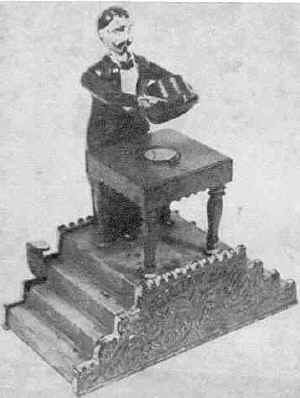The Magician Bank
by F.H. Griffith - HOBBIES Magazine - June, 1964
 A magician performing his feats of magic is one form of
entertainment with universal appeal, intriguing both young and old alike. The magician
seems to maintain and occupy a somewhat unique position as a performer and in turn his
counterpart or representation in a mechanical bank can be said to occupy a unique position
among the mechanical banks. While there are a certain number of the mechanicals that have
to do with magic in one form or another, there are none that more accurately depict the
magician than the Magician Bank itself, our choice as No. 120 in the numerical
classification. Very frankly this bank has always been one of the writer’s favorites
— it has good interesting action, an attractive appearance, a coin is a necessary
part of the action, and it is a well proportioned piece. Then, of course, the subject
matter, magic, very definitely adds to its desirability.
A magician performing his feats of magic is one form of
entertainment with universal appeal, intriguing both young and old alike. The magician
seems to maintain and occupy a somewhat unique position as a performer and in turn his
counterpart or representation in a mechanical bank can be said to occupy a unique position
among the mechanical banks. While there are a certain number of the mechanicals that have
to do with magic in one form or another, there are none that more accurately depict the
magician than the Magician Bank itself, our choice as No. 120 in the numerical
classification. Very frankly this bank has always been one of the writer’s favorites
— it has good interesting action, an attractive appearance, a coin is a necessary
part of the action, and it is a well proportioned piece. Then, of course, the subject
matter, magic, very definitely adds to its desirability.
The bank was patented January 22, 1901, by William C. Bull of Philadelphia, Pa., assignor to Abraham L. Kesner, also of Philadelphia. This, like a number of the mechanicals, was patented as a "money box," and the papers contain two drawings of the bank. In this case the bank as actually produced is considerably different than the original patent drawings. For example, the overall appearance and configuration of the actual bank, plus much of the mechanism, is quite unlike the drawings. The figure of the magician, the table, and general principle of operation are, however, somewhat similar. This is not an unusual circumstance as many of the mechanical banks are at variance with their respective patent papers. There were numbers of reasons for these changes, including a better operating bank, a more attractive item, more efficient operating mechanism, problems of casting parts, ease of assembly, and so on. In the specific case of the Magician Bank there is no question but that the changes made from the patent drawings resulted in a more attractive bank with better operation. It was manufactured by the J. & E. Stevens Company of Cromwell, Conn., and pictured in their catalog for 1906, but does not appear in the 1911 issue or any of their catalogs after that year.
The bank shown is in fine original condition with good paint. The back and front of the platform, which has steps on each side, are blue with yellow edgings. The name "Magician Bank" is in black. The steps and floor of the platform are a yellow-orange color. It is possible that this section may have originally had a pink or red flocking thereon to represent a rug. The writer has seen an example of this bank with a light coating of gray flocking over the steps and floor of the platform and there is no question in his mind but that it was originally made in this fashion. This does not preclude the possibility, however, that numbers of the Magician Banks were originally produced with this same section simply painted and no flocking applied. The table is red with gold edging on the legs. The magician’s outfit, including his hat, is black with a white shirt front and black bow tie. His hands and face are flesh color and his eyes, eyebrows, goatee, and elegant turned-up mustache are all black, as is his hair. A defined part of the casting of the hat is outlined in gold to represent a wand held in the right hand of the magician.
The bank operates as follows: A coin is placed on the provided section in the center of the table (note picture). The lever is then depressed. The magician lowers his hat covering the coin on the table and at the same time his head tilts forward as though observing his own actions. Upon releasing the lever the parts automatically return to the position as shown in the picture and the coin has disappeared. The magician, of course, is now ready for another coin so he can make it disappear too. Actually the coin rests on a trap door, the hat when lowered trips the trap and the coin slides into and down a chute through the legs of the magician and on into the base platform. The trap door is spring actuated so that it automatically returns to place when the hat is raised. It’s a clever action bank, well designed, and will work with any coins up to and including those the size of a quarter.
